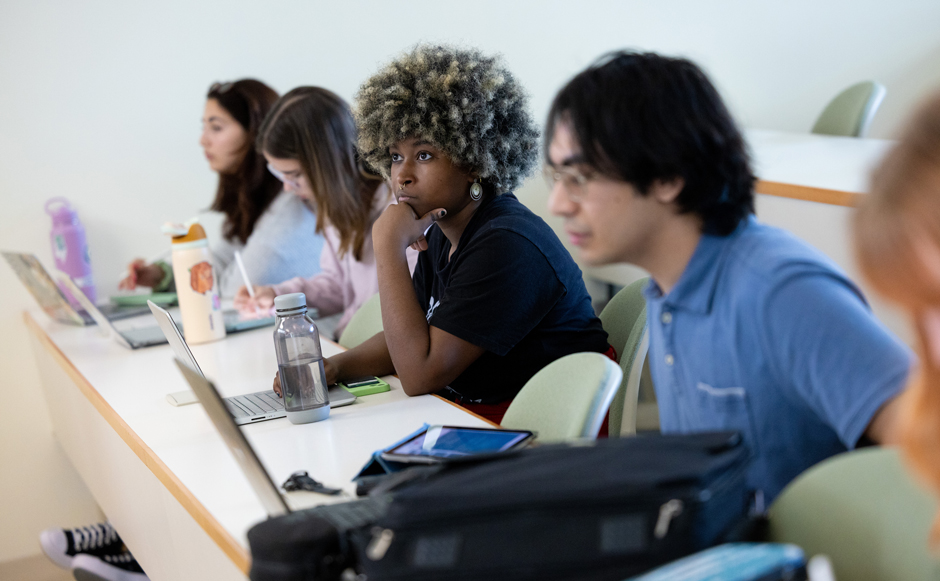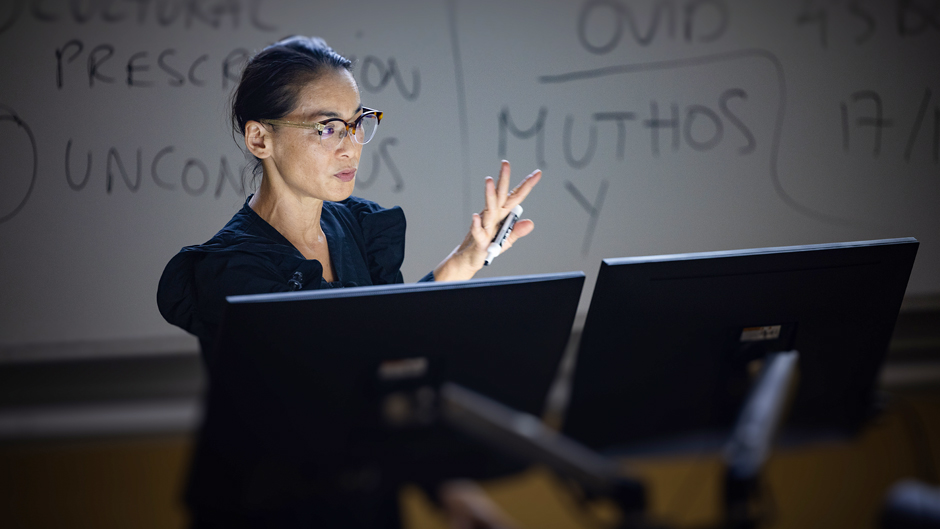Han Tran was always most comfortable immersed in a book.
Growing up in France, and later in Massachusetts, Tran spent much of her free time visiting bookstores or libraries.
Now Tran, a senior lecturer in the Department of Classics at the University of Miami College of Arts and Sciences, uses her lifelong interest in reading to enlighten students about Greek and Roman myths—some of the earliest recorded stories in history.
Tran’s soft-spoken ability to engross students in these legends, as well as her gentle nudging to think critically about a character’s motivations or the underlying messages, is often a change of pace for students. But her enchanting style has prompted many pre-med or pre-law students to add a classics major or minor to their academic goals, students and faculty said.
“I’m enthralled the entire class,” said Natalia Crespo, a classics major, who plans to go on to law school. “The stories are just so entertaining, and [Tran] tells them the way a mother revealing a good bedtime story would. At the end of class, you have a good grasp of what happened because she also connects it to other myths, so it’s easy to follow and you don’t get confused or lost.”

But Tran doesn’t just want students to leave her classes able to recall the names and purposes of gods and goddesses.
“These stories come from a certain place and were motivated by certain goals, so it’s good skill for students to understand the person behind the stories,” she said. “Hopefully, students are glad they have taken this class because we don’t just tell the story, they also think about why it was created. That’s what drew me into the field of classics in general.”
Classics chair and professor John Paul Russo has attended Tran’s classes many times, and said she is “one of the great UM lecturers of her generation.” Her knowledge of mythology and passion for art and art history intersect in a course she teaches called Monsters and Fantastical Creatures, and even more so in a new course she created after noticing references to mythology at Art Basel one year. The class, called Classical Myths and Contemporary Art, is also the subject of a book she is working on.
Her approach draws a swell of students who eagerly enroll in Tran’s courses, starting with the introduction level class Greek and Roman Mythology that attracts nearly 100 students three times a week. Health science major Soraya Salichs is taking it as an elective.
“There’s a twist in every story she tells, which really keeps me engaged and interested,” Salichs added.
Tran is humble about her ability in the classroom, refined through 18 years of teaching. She said Greek and Roman myths are simply great material.
“Everyone likes a good story, but the reason you’re drawn to myths is because you don’t quite understand them,” Tran said. “They operate on a different level from the one we typically do, and the logic is different. That’s why we read fairy tales. But Greek myths are not children’s stories—they are actually pretty gruesome.”
In a recent class, Tran projected different sculptures of Medusa on the smart screen, while explaining how the infamous gorgon often represents female sexuality because she is beautiful, yet dangerous.
Students enjoy hearing Tran’s interpretations because it builds on their cursory knowledge of mythology from grade school, video games, Hollywood films, and novels like the Percy Jackson series. It also allows them to understand how people used to make sense of the world, said Max Flores, a junior studying finance, who is already thinking about taking Tran’s next class.
“It’s so interesting and gives you a different perspective on what people thought back then,” he added.
The puzzle of unraveling these stories from ancient languages first drew Tran to mythology.
Born in Vietnam, Tran moved to Paris, France, at the age of 4, and began devouring books in French and English throughout her childhood. She also grew fond of art and still spends time each day painting and drawing. She hoped to become a writer.
Yet, as a young teen, Tran came across a renowned Belgian author named Marguerite Yourcenar. One of her favorite books was a historical fiction piece that chronicles the life of the Roman Emperor Hadrian, who traveled across the world.
“She wrote about the ancient world, so I had a glimpse of it through her work, and I thought it was interesting,” Tran said.
She loved the book, but really liked translating the chapter titles that were written in Latin. A few years later, Tran’s family moved to the United States, and she began reading T.S. Eliot’s poems. Again, she noticed some quotations in Greek and Latin.
“It was so foreign and strange that I wanted to understand it,” she said. “I wanted to make sense of the myths and why the Gods told all these stories.”
Tran spent her lunch breaks in high school teaching herself Latin. Later, she won a national award for her prowess in the language. And she realized she wanted to explore the field of classics, which delves into ancient societies, languages, and literature.
But Tran was also drawn to these early stories because it helped her explore other cultures. She believes this is one of the most important reasons to study Greek and Roman mythology today.
“By reading these stories, for many it’s a break from memorizing facts, but it also shows students a different way of experiencing the world. It’s more open-ended and free flowing than other subjects allow,” she said. “And it’s refreshing to think that whatever their career, it’s a way of thinking that can expand your world.”
Another practical application of understanding classical myths? They can help you fully appreciate western society today, Tran said. For example, the U.S. Supreme Court building and the White House were inspired by Greek and Roman temples.
“Western culture is deeply rooted in these worlds, so whether we like it or not, we do ourselves a great favor by understanding that these stories have played a large part in our language, institutions, and in artwork,” she said.
